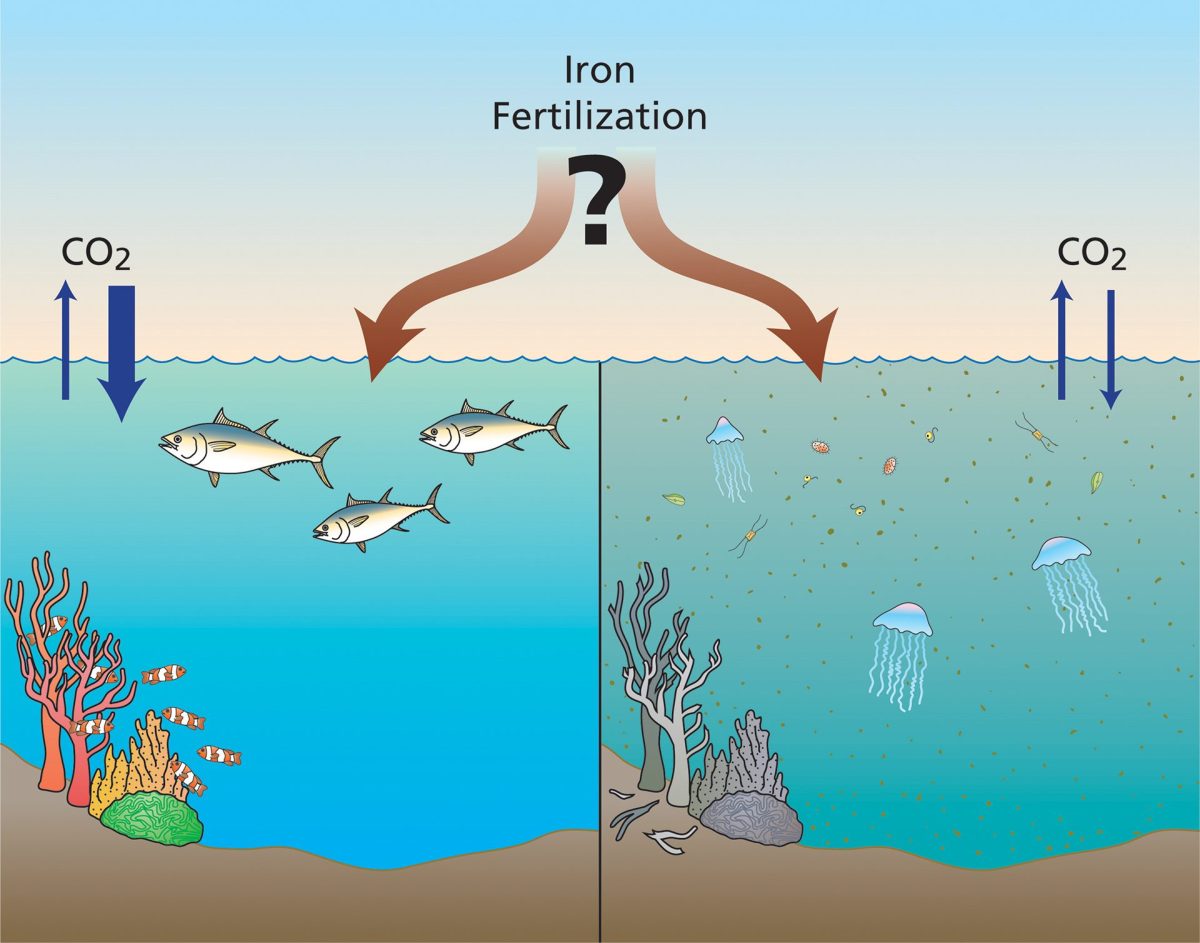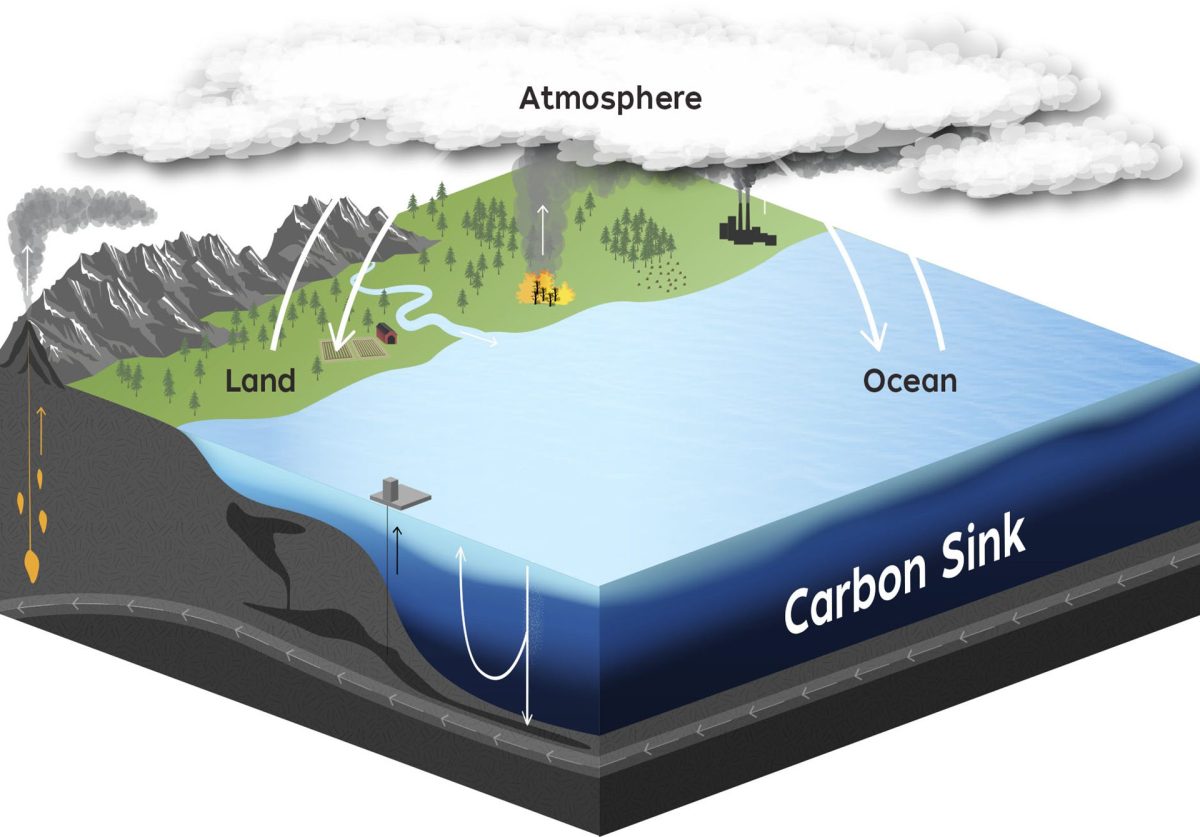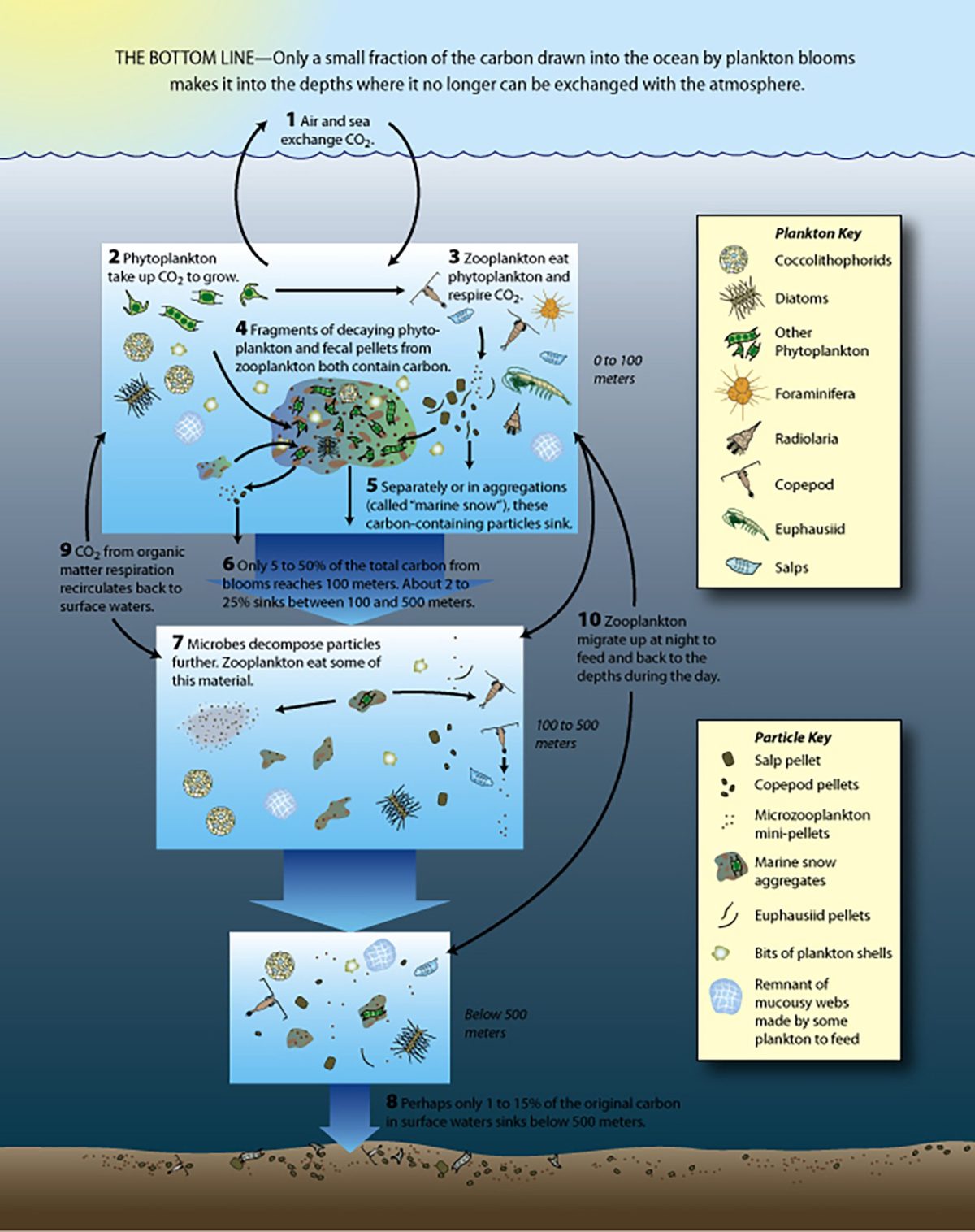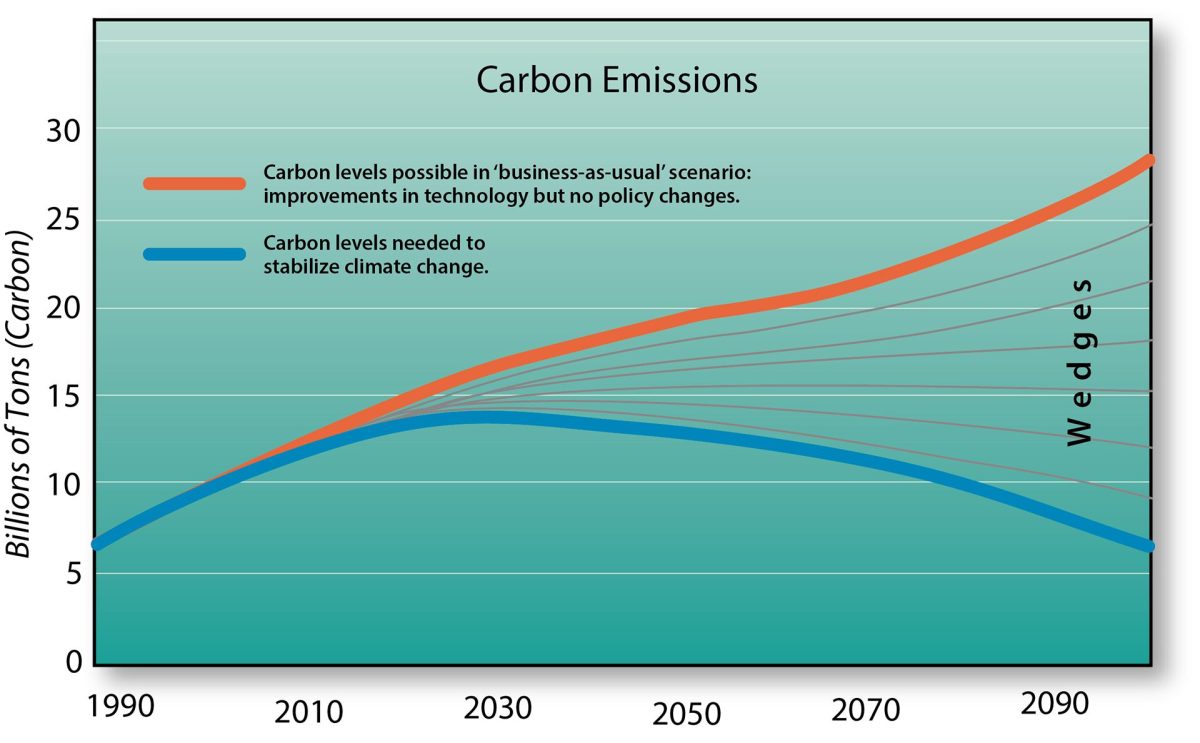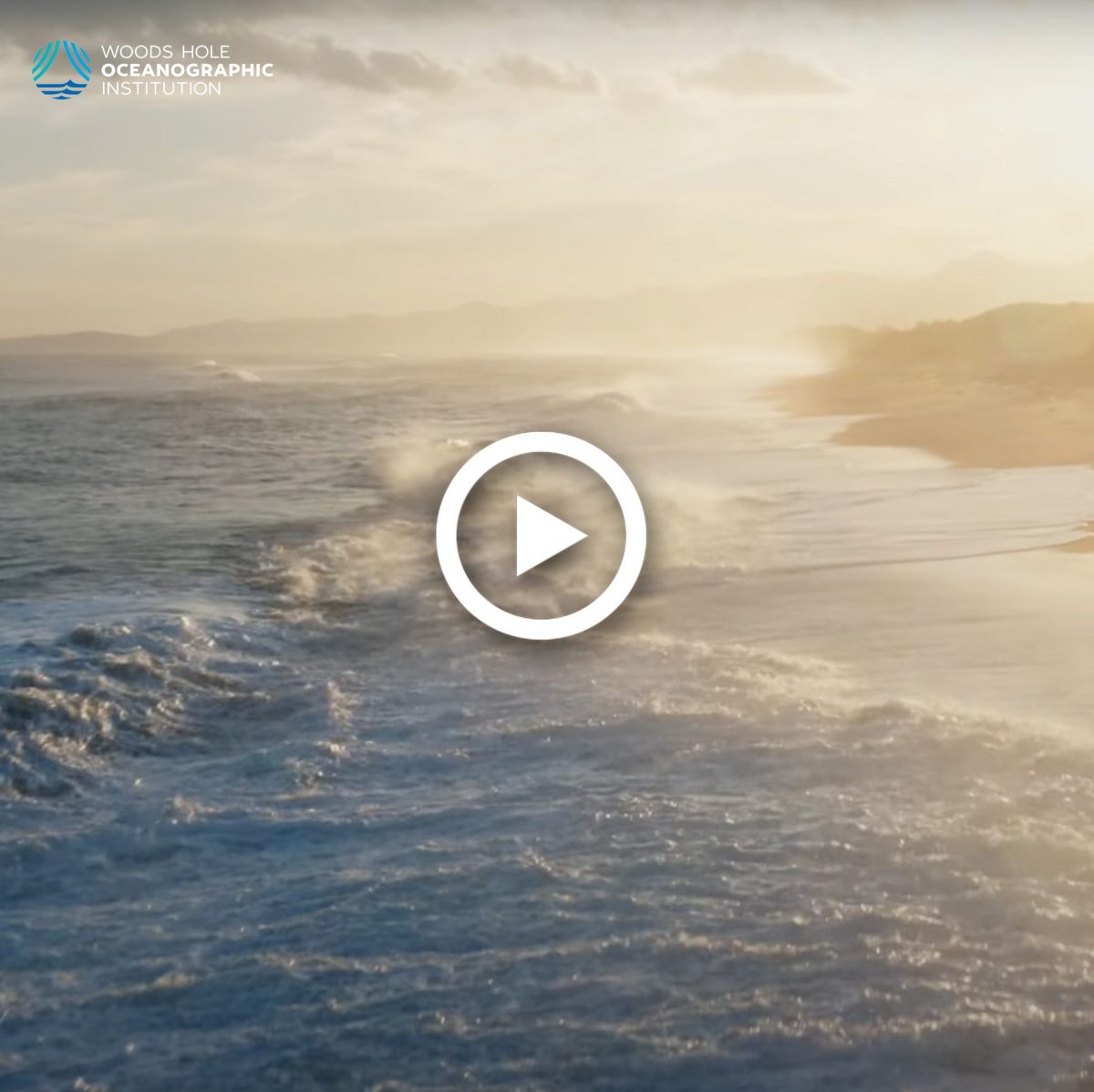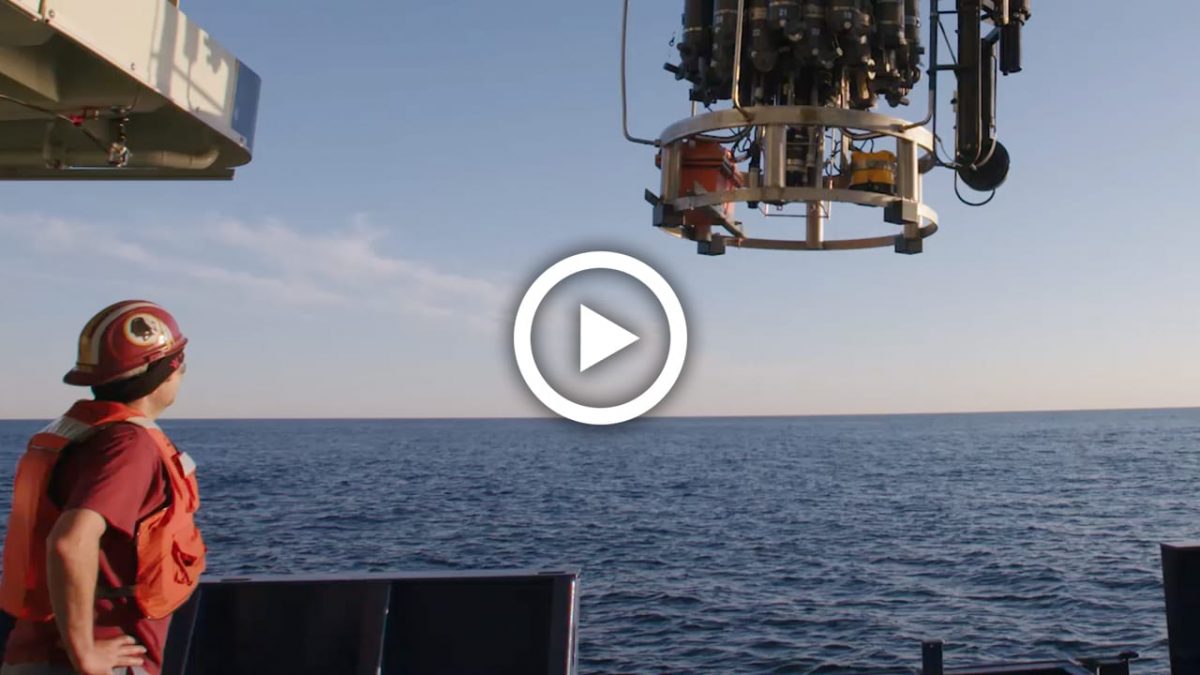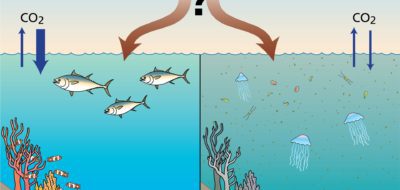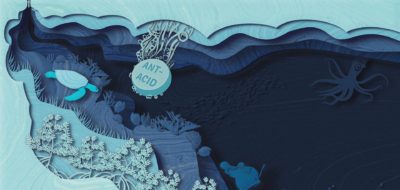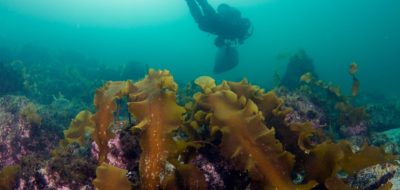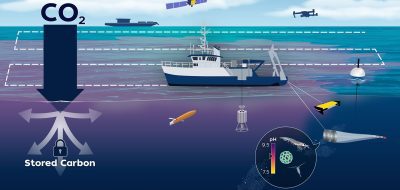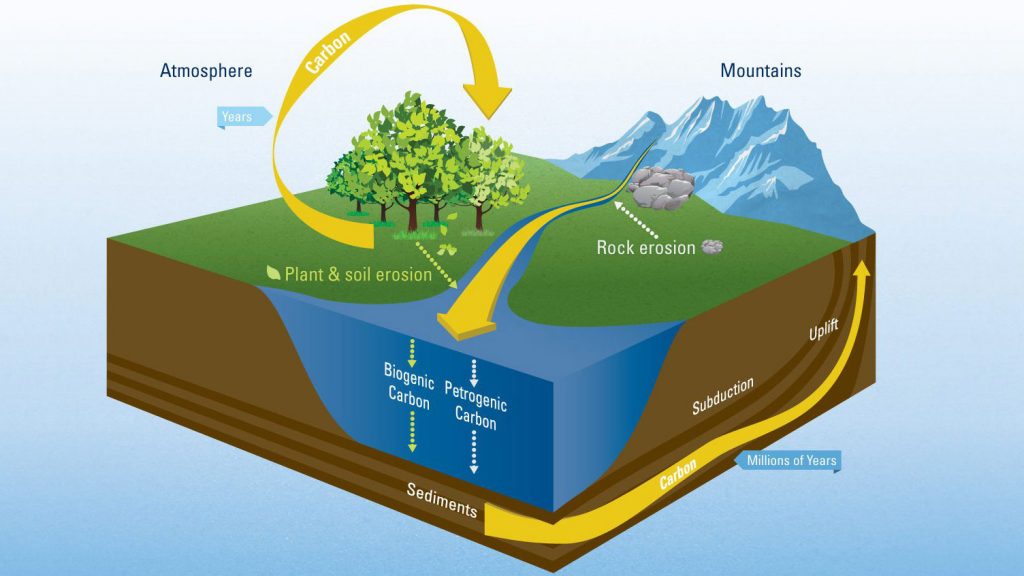
The worlds river systems sequester atmospheric carbon dioxide by transporting decaying organic material from land to the ocean. Although river transport of carbon to the ocean is not large enough to bail humans out of our global warming problem, knowing how much carbon rivers transport is important part of understanding the global carbon cycle that regulates Earth's climate. Scientists from WHOI recently calculated the first direct estimate of how much and in what form organic carbon is exported to the ocean by rivers. (Illustration by Eric S. Taylor, WHOI Creative © Woods Hole Oceanographic Institution)
What is carbon?
The chemical element carbon is a building block for all life on Earth. Carbon is in humans, plants, and animals; carbon is a food source; and it’s stored in the coal and oil that powers our lifestyles.
Carbon constantly flows among various Earth systems, or carbon reservoirs, in what’s known as the global carbon cycle. Terrestrial plants, soil, and the ocean all transfer carbon and act as carbon sinks, meaning they capture and store carbon on long timescales. For example, plants absorb carbon dioxide from the atmosphere to photosynthesize and build their structures; when the plant dies and decays, some of this stored carbon moves into the soil, where it can remain for centuries to millennia.
The carbon cycle is one of several biological and physical processes that naturally maintain Earth’s carbon balance and make the planet habitable. While the distribution of carbon in the atmosphere and Earth systems such as the ocean fluctuates, the actual amount of carbon in existence doesn’t change over time because Earth is a closed system.
Modern human activities and their dependence on fossil fuels disrupt the carbon balance. Burning coal and oil releases carbon that would otherwise remain stored in the ground and adds it to the atmosphere as carbon dioxide, a heat-trapping greenhouse gas that warms the planet and causes climate change.
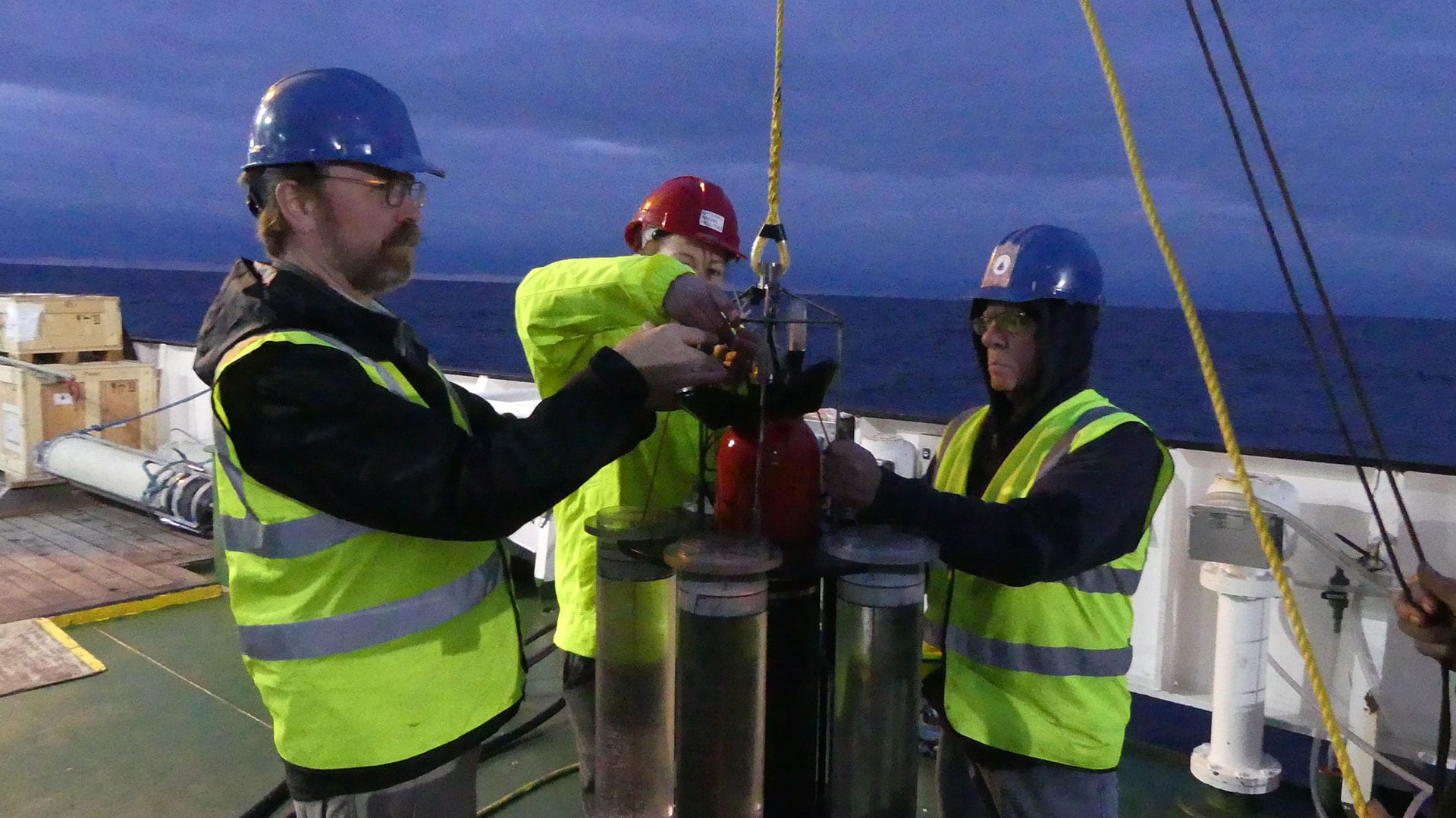
Collecting carbon clues—Marine chemist Ken Buesseler (left) and research specialist Steven Pike prepare to deploy a sediment trap to gain insight into the role of the upper ocean in Earth's carbon cycle and climate system. (Photo by Jennifer Kenyon, Woods Hole Oceanographic Institution)
What is blue carbon, and why does it matter?
Blue carbon refers to the atmospheric carbon captured and stored by the ocean in various ecosystems and organisms. This activity mitigates the effects of climate change by storing carbon for long periods, often thousands of years or more. The tidal marshes, mangrove forests, and seagrasses found in coastal areas hold the most blue carbon, but marine organisms and biological processes in the open ocean also sequester carbon.
Scientists estimate that the ocean and coastal ecosystems absorbed nearly 30 percent of the carbon dioxide added to the atmosphere each year by fossil fuel use over the past few decades. The carbon storage capacities of various ocean ecosystems is an emerging field of research; however, scientists already know that these vital habitats contain significant amounts of carbon, and they’re in rapid decline.
The destruction and loss of shoreline ecosystems, largely the result of real estate development and erosion, lead to fewer places to store carbon and release the carbon held in their sediments. Both events increase the amount of carbon dioxide emitted into the atmosphere, further contributing to climate change.
Coastal ecosystems also protect communities from rising seas, flooding, and other impacts of climate change, in addition to providing habitats for marine life. For this reason, preserving blue carbon sinks is not just about ensuring their future carbon storage potential.
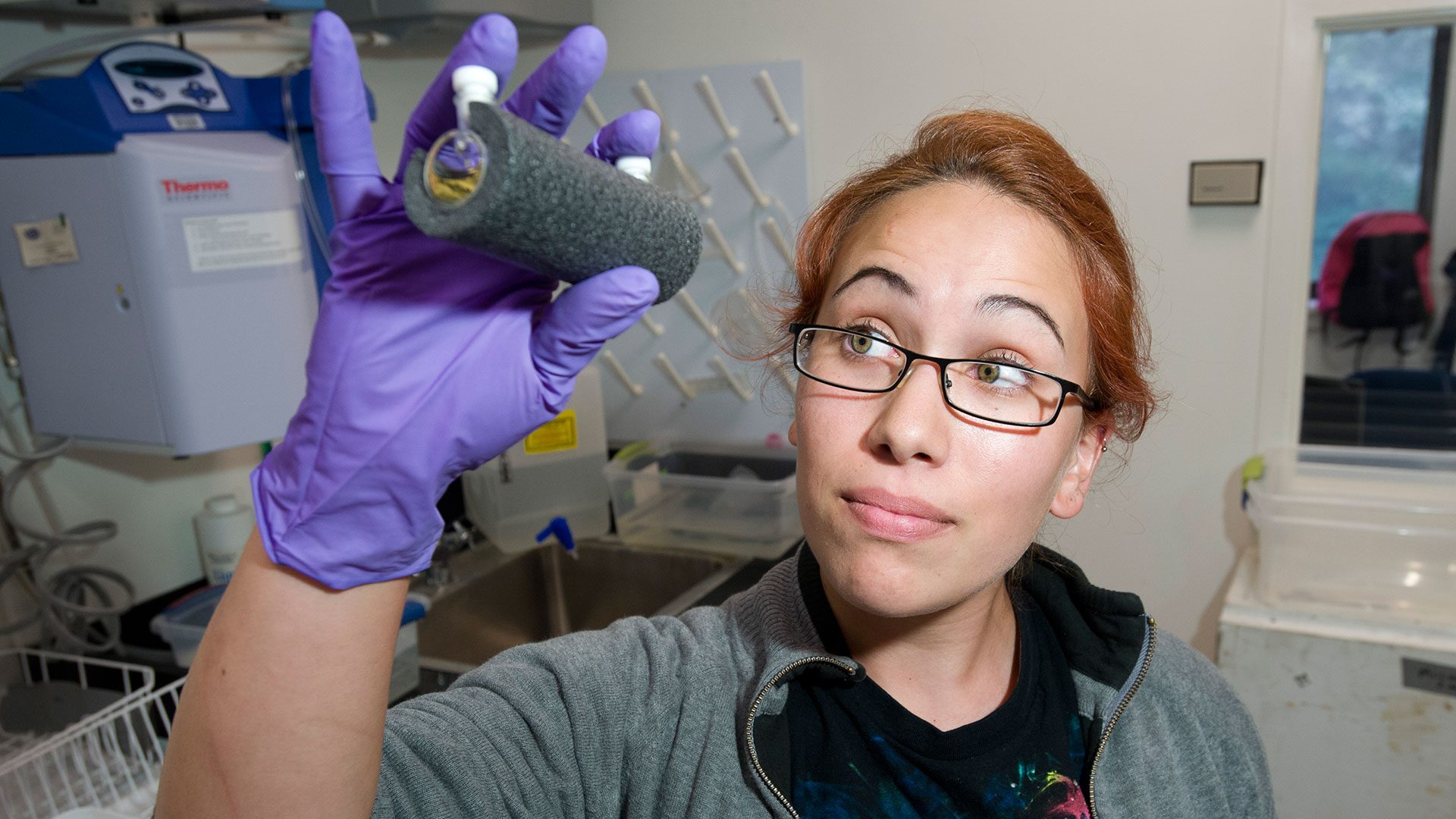
Alterra Sanchez, a 2013 Summer Student Fellow from San Diego State University, readies an optical cell for making pH measurements in a high-precision spectrophotometer. The cell contains a pH indicator and seawater from a local marsh. Each summer, Fellows team with WHOI scientists on a wide range of oceanographic research. Sanchez worked with marine chemists Zhaohui 'Aleck' Wang of WHOI and Kevin Kroeger of USGS on a "blue carbon" project that examined the marsh's ability to export carbon dioxide to coastal waters. (Photo by Tom Kleindinst © Woods Hole Oceanographic Institution)
How does the ocean store carbon?
The ocean has a central role in the carbon cycle. It constantly exchanges carbon dioxide with the atmosphere, and some of this carbon dioxide dissolves in the surface waters. There, billions of tiny plant-like organisms called phytoplankton turn the carbon into organic matter through photosynthesis. When phytoplankton die, their remains fall to the seafloor and are locked away in ocean sediments.
A smaller carbon sink comes from the activity of corals and many other organisms in the marine food web that use the carbon dioxide dissolved in the ocean to create their calcium carbonate shells and skeletons.
Coastal ecosystems also capture and store massive amounts of carbon in both plants and sediments for centuries or longer. Together, the plants and soils in tidal salt marshes, seagrass meadows, and mangrove forests sequester roughly ten times more carbon per unit area than terrestrial ecosystems. Disturbances to these fragile marine ecosystems, such as eutrophication or the overabundance of nutrients in runoff, storm surges, and coastal development, can release this carbon back into the atmosphere and ocean.
These processes make the ocean Earth’s largest active carbon sink—there’s 50 times more carbon in the ocean than in the atmosphere; this is why the ocean has such a significant role in storing atmospheric carbon dioxide. The tidal salt marshes, seagrass meadows, and mangroves that make up coastal ecosystems stow away half of all carbon stored via carbon burial; deeper waters lock away most of the rest.
The ocean’s ability to soak up carbon dioxide and sequester carbon can’t keep up with the pace of current greenhouse gas emissions, leading to increased carbon dioxide in the atmosphere. By cutting carbon emissions and maintaining ocean health, we can ensure that the ocean continues its critical role in the carbon cycle.
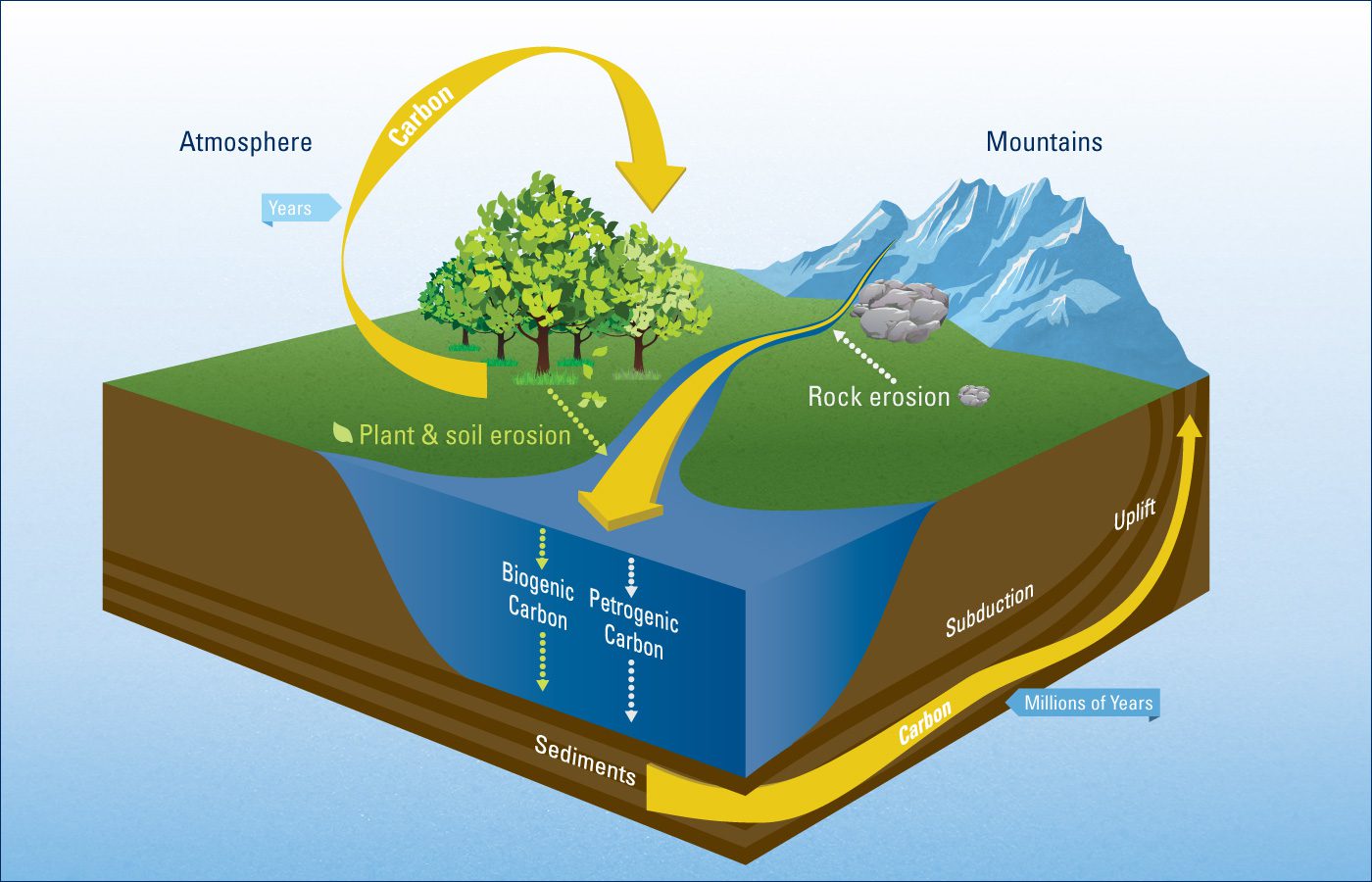
The worlds river systems sequester atmospheric carbon dioxide by transporting decaying organic material from land to the ocean. Although river transport of carbon to the ocean is not large enough to bail humans out of our global warming problem, knowing how much carbon rivers transport is important part of understanding the global carbon cycle that regulates Earth's climate. Scientists from WHOI recently calculated the first direct estimate of how much and in what form organic carbon is exported to the ocean by rivers. (Illustration by Eric S. Taylor, WHOI Creative © Woods Hole Oceanographic Institution)
What is the ocean’s biological pump?
Phytoplankton floating in the ocean’s surface layer continually transport carbon dioxide to deeper waters through a set of processes central to the carbon cycle called the biological pump.
Each day, these tiny plant-like organisms consume carbon dioxide during photosynthesis and convert it into the organic carbon they need to grow. When phytoplankton die or are eaten, their remains sink through the water column to the deep ocean and seafloor.
There, the remnants may be consumed by other species or buried in sediments. Either pathway locks away the carbon for months to centuries or longer. The deeper the remains fall, the more time it takes the carbon to cycle back into the atmosphere.
The biological pump helps regulates global climate: An estimated 25 percent of atmospheric carbon dioxide ends up “pumped” into the ocean by phytoplankton. This activity enables the sea take up between 5 and 12 gigatons of carbon dioxide each year.
What are scientists doing to understand blue carbon?
Without the carbon cycle and the ocean’s moderating effect on climate, Earth would be much hotter than it is today. But whether this blue carbon will remain in the sea, and for how long, is unknown. However, we know that once carbon is released back into the atmosphere, it will accelerate global warming.
Blue carbon’s significance in the carbon cycle is a recent discovery, and scientists are working to better quantify the amount of carbon absorbed and stored by the ocean. Questions also remain about how the biological pump may function as climate change continues to warm the ocean.
WHOI scientists are furthering knowledge of blue carbon through two large research projects: The Ocean Twilight Zone initiative and NASA’s EXport Processes in the global Ocean from RemoTe Sensing (EXPORTS) program. The scientists driving this transformative research aim to understand and predict the carbon cycle. The results of these studies and others at WHOI will inform climate model experiments that aim to predict how the biological pump and ocean’s role in the carbon cycle might respond to climate change.
Other WHOI researchers recently put an economic value on the benefit of research to improve knowledge of the biological carbon pump and reduce the uncertainty of ocean carbon sequestration estimates. They estimate that the global economic benefit of studying the ocean’s biological pump is $500 billion if the science leads to policy decisions that mitigate climate change impacts.
Buesseler, K.O., et al. Metrics that matter for assessing the ocean biological carbon pump. Proceedings of the National Academy of Sciences, 117 (18) 9679-9687. doi: doi.org/10.1073/pnas.1918114117.
Honjo, S., et al. Understanding the role of the biological pump in the global carbon cycle: An imperative for ocean science. Oceanography 27(3). doi: https://doi.org/10.5670/oceanog.2014.78.
NASA. The Carbon Cycle. https://earthobservatory.nasa.gov/features/CarbonCycle. Accessed on March 4, 2021.
NOAA. What is the carbon cycle? https://oceanservice.noaa.gov/facts/carbon-cycle.html. Accessed on March 4, 2021.
Macreadie, P.I., Anton, A., Raven, J.A. et al. The future of Blue Carbon science. Nat Commun, 10. doi: doi.org/10.1038/s41467-019-11693-w.
Mcleod, E., et al. A blueprint for blue carbon: toward an improved understanding of the role of vegetated coastal habitats in sequestering CO2. Frontiers in Ecology and the Environment, 9: 552-560. https://doi.org/10.1890/110004.
Tollefson, Jeff. Climate scientists unlock secrets of ‘blue carbon.’ Nature, 553, 139-140. doi: doi.org/10.1038/d41586-018-00018-4.
- https://www.whoi.edu/press-room/news-release/the-oceans-biological-pump-captures-more-carbon-than-expected/
- https://www.whoi.edu/news-insights/content/the-ocean-twilight-zones-crucial-carbon-pump/
- https://www.whoi.edu/press-room/news-release/the-500-billion-question-whats-the-value-of-studying-the-oceans-biological-carbon-pump/



